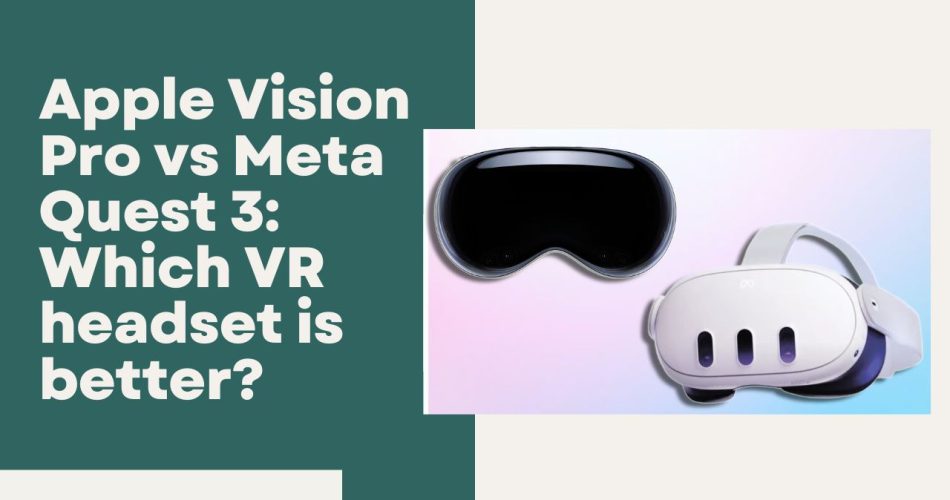The era of immersive computing is here. Two major players in this space are Apple with their Vision Pro headset and Meta with the Quest 3. But which one is better for most users? Let’s compare the key features and capabilities of both headsets to help you decide.
Overview and Pricing
The Apple Vision Pro starts at $3499, positioning it as a premium device packed with advanced features. In contrast, the Meta Quest 3 has a consumer-friendly price point of $499 for the 128GB model.
Clearly, there is a massive difference in pricing. The Vision Pro costs over 7 times more than the base Quest 3. This price gap reflects major differences in the target audience, specs, overall capability, and ecosystem.
See More: Can You Install SnapTube on iOS?
Design and Ergonomics
Apple has designed the Vision Pro using premium materials like aluminum alloy, glass, and fabric. It looks futuristic yet elegant. The complex internal setup is miniaturized to keep weight at around 600-650g.
Comfort is enhanced by the Light Seal ring which flexes to fit your face. The back panel helps balance the weight by integrating the compute, cooling, and batteries. Overall, Apple has paid close attention to ergonomics.
The Quest 3 retains a plastic body similar to its predecessor, the Quest 2. However, the redesigned strap and pancake lenses contribute to a more balanced front-heavy weight of 515g. The default elastic strap offers basic support which can be upgraded with alternatives.
So, the Vision Pro offers a more polished, comfortable, and customized fit suited for extended use. The Quest 3 provides good ergonomics considering its much lower price tag.
Displays and Optics
The Vision Pro utilizes cutting-edge micro-OLED displays with high resolution – over 23 million pixels and a pixel density of 2000 PPI. The custom optics by Zeiss offer stunning visual clarity across the large field of view.
Comparatively, the Quest 3 also houses high-resolution LCDs adding up to 4K visuals per eye. The new pancake lenses increase the field of view to 110 degrees with minimal distortions.
Clearly, the Vision Pro’s displays are far more advanced and lifelike. But the Quest 3 also provides a compelling and immersive 4K VR experience.
Performance and Features
Apple has packed custom Apple silicon including a powerful M2 chip and a new R1 chip focused on graphics. The Vision Pro offers hand tracking, and eye tracking with dynamic foveated rendering and spatial audio.
The Quest 3 is no slouch either with the latest Snapdragon XR2 Gen 2 platform offering smoother graphics and AI processing. It also features mixed reality with full color passthrough AR.
The Vision Pro brings Apple’s sophisticated hardware/software integration to provide a groundbreaking spatial computing platform. In comparison, the Quest 3 focuses more on accessible mainstream VR with some AR capabilities.
Ecosystem and Apps
A key advantage for Apple is their expansive ecosystem spanning iPhones, Macs, and Apple TV for seamless connectivity. App developers are optimizing popular iOS apps for Vision Pro.
In contrast, Meta has nurtured a dedicated library of VR games and apps for years. The Quest 3 provides access to this robust content catalog from day one.
Hence, Vision Pro offers integration with Apple’s services but needs to build a suite of optimized spatial apps. The Quest 3 instantly delivers a mature library of VR apps and games.
Verdict
The Apple Vision Pro pioneers a new category of spatial computers with breakthrough technology but carries a luxury price tag. The Meta Quest 3 brings significant upgrades for immersive VR gaming at an affordable cost.
Casual VR users who want an easy entry point should consider the Meta Quest 3. Tech enthusiasts excited about next-gen experiences may desire the Apple Vision Pro despite the high pricing.
Both headsets have pros and cons catering to different audiences. But the era of immersive mixed reality is just getting started. We can expect rapid innovation in this space in the coming years with more choices across the pricing spectrum.

